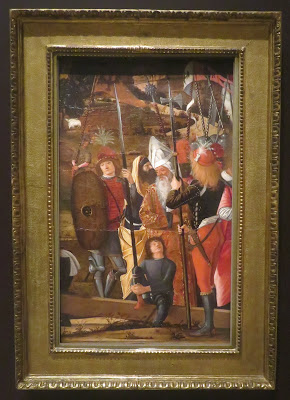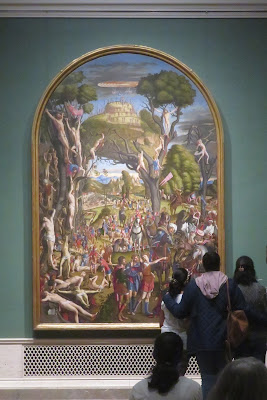Early on in the exhibit you encounter two relatively small paintings that are absolutely charming. One is of a male figure and the other a female. The idea is that there were originally three works and that they were embedded in a piece of furniture, a cabinet. The figure of the man represents the classic Hercules, and on either side was this and another woman. The surviving female figure represents virtue, while the missing one would have been vice, and in the middle was Hercules choosing virtue over vice.
Allegorical Figure (Virtue?), circa 1498
private collection
Youth (Hercules?) in a Landscape, circa 1498
Accademia Carrara, Bergamo, Italy
Another early work that I found interesting is a work depicted a group of men in various dress. One figure is seated, and his proportions are, to put it simple, off. Painted in the early/mid 1490's what you see in this painting that you soon no longer see is this sort of miscalculation in proportions. But what you also see are the amazing a subtle depictions of countenance that express a profound sense of the humanity of the subject.
Group of Soldiers and Foreigners, circa 1493
Gallerie degli Uffizi, Florence, Italy
detail of seating figure in foreground
Included among the paintings are also some intricate and gorgeous drawings. I was immediately reminded of the works of a pair of artist friends of mine who spent a semester living in northern Italy during Jennifer's grad school experience at American University here in DC. While Jennifer worked on her senior thesis, Andy made with amazing little mono-type prints inspired by the Renaissance city-scapes of the villages in the region. I am blessed to have one of Jennifer's large works from the experience and one of Andy's intimate prints in my home as part of my personal collection.
Fortified Harbor with Shipping, 1495
British Museum, London, United Kingdom
Two Groups of Monks, circa 1502
The Syndics of the Fitzwilliam Museum, University of Cambridge, United Kingdom
It is in the third gallery that you begin to encounter larger works, and you can see in these two how Carpaccio's technique is growing along with the size of the paintings.
Saint Augustine in his Study, shortly after 1502
Scuola Dalmata dei Santi Giorgia e Trifone, Venice, Italy
Saint George and the Dragon, circa 1504-1507
Scuola Dalmata dei Santi Giorgia e Trifone, Venice, Italy
The fourth gallery is lined with major works executed in a mature style. Delightful compositions full of details and commerce and social intercourse.
Ordination of Saint Stephen, 1511
Staatliche Museen zu Berlin, Gemaldegalerie, Berlin, Germany
The Martyrdom of the Ten Thousand Christians on Mount Ararat, 1515
Gallerie dell'Accademia, Venice, Italy
This one cracked me up a bit, I must admit to having chuckled aloud. Not painted to be displayed in the context of one another, it still felt like three contestants on some divine game show like "Which Martyr Is Worthy?" And there you have poor old St. Roch with a booboo on his thigh, while while St. Peter Martyr looks on with a freaking machete bisecting his tincture-doo!
L-R:
St. Peter Martyr, 1514
Fondazione Musei Civici di Venezia, Museo Correr, Italy
Saint Sebastian, 1514
Strossmeyer Gallery, Zagreb, Croatia
Saint Roch with Antonio (?) Lippomano as Donor, 1514
Accademia Carrara, Bergamo, Italy
God the Father, circa 1518 - 1520
Perish Church of Santi Nabore e Falice, Sirtori Comune (Lecco province) Italy
CODA: You know, I don't claim to be an expert on Art History. If anything I subscribe to the Sister Wendy school of art criticism: "Let your heart lead you, learn what can, and then trust what you see."
When leaving the gallery I visited the gift shop. I was interested in the catalogs for both the Sargent in Spain and the Carpaccio exhibits. They were conveniently stacked near the cashier. Neither had any indication of price on them. I've a collect of nearly 100 art catalogs from shows that I've seen over the years, so I do know what to expect generally. I waited for the cashier, a pretty, plump-ish young woman to finish with a customer making a purchase and then I inquired.
I said, "Can you tell me the price of the Sargent and Carpaccio exhibit catalogs?"
When leaving the gallery I visited the gift shop. I was interested in the catalogs for both the Sargent in Spain and the Carpaccio exhibits. They were conveniently stacked near the cashier. Neither had any indication of price on them. I've a collect of nearly 100 art catalogs from shows that I've seen over the years, so I do know what to expect generally. I waited for the cashier, a pretty, plump-ish young woman to finish with a customer making a purchase and then I inquired.
I said, "Can you tell me the price of the Sargent and Carpaccio exhibit catalogs?"
She replied, "The Sargent catalog is $--- and the Car-a-paccio catalog is $----"
Hmm... I thought, "Kaar-AH-pach-e-o"? She emphasized the second syllable. I glanced at the spelling once again. C-a-r-p-a-c-c-i-o. I don't pretend to speak Italian. The one time I was stranded (on Christmas Eve, mind you) on a train just north of Florence--standing room only, packed in like sardines--I relied on the assistance of another young man from the Dominican Republic who could speak Italian and my half-assed Spanish to carry on a conversation and speculate on the cause of our delay! I do; however, eat Italian, and even humbly cook Italian. I am familiar with the Italian appetizer/dish called Carpaccio. AND I understand the rudimentary rules for pronouncing Italian words.
On the other hand, I am not an under-graduate student majoring in Art History at American University living away from home for the first time in my life and working at the National Gallery of Art's gift shop over Christmas break with dreams of one day owning the place. Car-a-paccio...if you say so.
















No comments:
Post a Comment